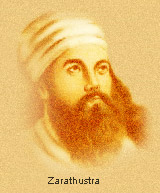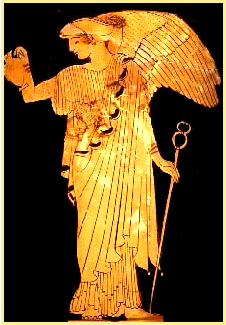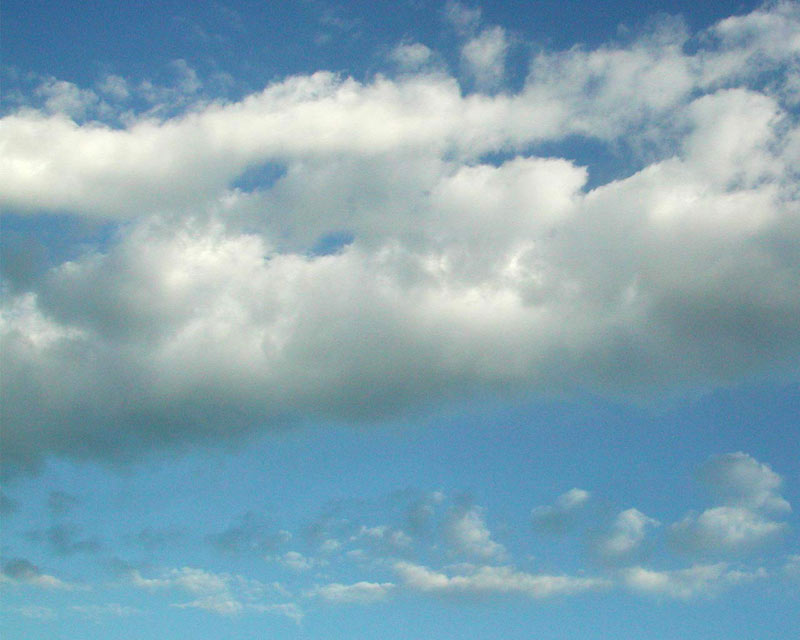2007/08
These beautiful things that flow about like commas in the sky
are serendipid moments bumping into each other,
and they can never be imagined
no matter how hard you try.
These wonderful things that are dancing through the ether,
are timeless quotations arriving at the exact moment
to crystalise a thought that has
barely taken its birth.
These precious things drift upon the stream and arrive at your feet
like a child delivering nothing but joy
and talking with her eyes in a way
that adulthood forgets.
These eternal things weave through and through the universe
like melodies echoing from ear to ear,
bringing fond scents and reminiscences
and dissolving into time.
These glorious fleeting things escape our earnest intentions,
and are grasped not with will, but synchronicity.
They are prophets busy reminding us that we
are flowing with the beauty of things.
Melissa Richard
(Photograph: geekphilosopher.com)
 “Shri Mataji has described Zarathustra (Zoroaster) as one of the 10 Adi Gurus looking after our void, situated on our left side. Many do not know, that Zarathustra incarnated in Persia much before others and His vision of the world has left some traces on Judaism and Christianity which came much later. Today in terms of numbers Zoroastrians are very few in the world, but the rich heritage of human spiritual thought that Zarathustra has left behind is still very appropriate and typical to today’s world. The basic teachings of Zarathustra give an essence of his revelations, Zarathustra’s vision of the world and his heritage to humanity in the form of revealed religion known as Zorashtrianism.
“Shri Mataji has described Zarathustra (Zoroaster) as one of the 10 Adi Gurus looking after our void, situated on our left side. Many do not know, that Zarathustra incarnated in Persia much before others and His vision of the world has left some traces on Judaism and Christianity which came much later. Today in terms of numbers Zoroastrians are very few in the world, but the rich heritage of human spiritual thought that Zarathustra has left behind is still very appropriate and typical to today’s world. The basic teachings of Zarathustra give an essence of his revelations, Zarathustra’s vision of the world and his heritage to humanity in the form of revealed religion known as Zorashtrianism.
“Like many of the great prophets Zarathustra established the one God, whom he called Ahura Mazda, as the basis of belief. After a period of meditation in the wilderness he realised the singular Self (the ‘One without another’ described in the Upanishads) and wanted people to turn their attention away from distracting multiplicity and towards that singular Self. However, this Monad was not a dreary monolith; it was more like a multi-faceted jewel. In order to bring about the creation and maintenance of the world it gave forth six divine beings (known as Amesha Spentas) which, including itself made up a sevenfold creation. The old Iranian deities, which are archetypes, found all over the ancient polytheistic world from Egypt to India were not abandoned entirely but were identified with these seven angelic beings or Immortals…
“Zoroastrian refugees arrived in the Gujarat region of India in the 8th century AD, and it is not surprising that in the relatively tolerant atmosphere of the Hindu culture into which they were received, some Parsi thinkers looked for, and found, similarities between their cosmology and that of the Hindus. The Seven Amesh Spentas described by Zoroaster in his Gathas have been compared by some Indian Parsis, with the Seven Chakras (subtle centres) of yoga tradition, each of which also represents an aspect of Creation…
“In the Zoroastrian system Wisdom is necessary for Knowledge, Knowledge is necessary for Harmony with nature, Harmony with nature leads to Righteousness and Love, which leads to Perfection, which leads to Immortality and thence to self-realisation. Zarathustra described the seven qualities of the One, not merely to make a compromise with the old religion of many deities. He wanted his followers to strive to awaken these qualities in themselves. His concept of emanations from the Godhead formed the foundation of Gnostic Christianity and influenced the development of the mystical aspect of Judaism – the Kabbalah.
“Benevolence towards others is the essence of the prophet’s teaching, encapsulated in the words: ‘Good Thoughts, Good Words, Good Deeds’. Many subsequent prophets have imparted similar teachings and it is easy to underestimate the revolutionary nature of Zarathustra’s ideas; one of the most important being the concept of free will. Followers of Monotheistic religions owe much to Zarathustra and could benefit from his concept of a single God with multiple creative aspects, both masculine and feminine. In yoga these are conceived of as seven flower-like spiritual centres, each with its abiding deity or aspect of the Self, on a single Tree of Life.”
Excerpts from Nirmal Fragrance. Pune, India: Nirmal Infosystems & Technologies, 2005.
(Photograph: ajna.com)
 The goddess Iris is the messenger of the Greek gods, and the personification of the rainbow. Like the Kundalini, she is a bridge connecting the human world with the divine. In yoga tradition it is said that union with the divine Self is impossible without the ascent of the Kundalini energy from the sacrum at the base of the spine.
The goddess Iris is the messenger of the Greek gods, and the personification of the rainbow. Like the Kundalini, she is a bridge connecting the human world with the divine. In yoga tradition it is said that union with the divine Self is impossible without the ascent of the Kundalini energy from the sacrum at the base of the spine.
Iris is particularly associated with the supreme goddess Hera (Juno), the wife of Zeus. Callimachus portrays Iris as sleeping under Hera’s throne. The throne of the Goddess is the Kundalini (called Merkabah in Hebrew).
It was sometimes said that Iris’s husband was the west wind, Zephyrus, the gentlest and most welcome of winds. When awakened within the subtle system of the body, the Kundalini is experienced as a gentle, cool breeze.
Her attributes are the caduceus and the vase of water from the river Styx. The caduceus is a symbol of the subtle system through which the Kundalini rises. It consists of a central staff (the Sushumna Nadi of Yoga) entwined by twin serpents (Ida and Pingala Nadis). The Kundalini is described as a serpent-like energy. Both the caduceus and Kundalini are associated with healing. The vase (Indian Kumbha) is a symbol of the Kundalini itself.
In Greek myth, Iris was often summoned to be present at councils of the gods so that she could pour out the Styx water and thereby discover whether or not truth was being told. Kundalini awakening is believed to confer the ability to discriminate truth directly on the nervous system.
Graham Brown
(Photograph: inf.nyme.hu)
 The Swadisthan chakra is placed at the level of the hip and is suspended like a satellite on a cord from the Nabhi chakra (located in the area of the navel). It moves around the Void (located in the abdominal area) , giving sustenance to any weak areas.
The Swadisthan chakra is placed at the level of the hip and is suspended like a satellite on a cord from the Nabhi chakra (located in the area of the navel). It moves around the Void (located in the abdominal area) , giving sustenance to any weak areas.
The quality of Swadhistan on the right side is creativity, i.e. truly inspired thoughts, ideas and actions. The quality of Swadhistan on the left side is pure knowledge, i.e. the truly discerning and discriminating power to see the innate nature of things at a new stage in our awareness called vibrational awareness.
Sahaja Yoga affirmations to open and clear the Swadisthan chakra include, “Mother, please give me the true knowledge,” “Mother, please make me the creative knowledge,” and “Mother, verily You are the doer and enjoyer.”
At the Swadisthan chakra the energy and purity of our creativity are generated. On the right side it manifests as intellect; on the left side as imagination. These aspects integrate in the central channel creating our aesthetic sense.
The development of aesthetics was the third step in human evolution when humanity transcended the audiovisual senses. For the first time humanity entered the abstract; we could imagine, forecast and conceive of images or ideas beyond the senses. Moreover, this asthetic sense can discern true beauty, and so the Swadhistan is capable of authoring truth concepts and ideas that are auspicious, i.e. pleasing to the Divine.
To create, one first has to be a visionary. One has to have the capacity to project something beyond the three dimensions. Animals don’t have this capacity; it is a special gift to humans. The one who has true genius becomes a creative force, an avant-garde, the forerunner of society. Scientists like Einstein, artists like Monet, composers like Mozart, writers like Shakespeare are capable of inspired works. Often they proclaim their minds were vacant at the time of their in-spirit-ation, and so the meditative state is best for achieving the best inspirational ideas and activities. This is consistent with being in the “zone” of high level achievement in many endeavours including reflecting on or thinking about things.
Unfortunately, human beings have a tendency to pursue everything to extremes. The Swadisthan centre is also responsible for breaking down fat particles in the abdomen to replace the grey and white cells of the brain, thus regenerating the capacity for thinking. Non-stop thinking exhausts the right Sun/Pingala channel and swells the ego. This pushes the superego down and thus severs the connection with the central channel which is nurtured by the All-pervading Spirit, the real reservoir of creativity. Instead of a sponge, the brain becomes like a rock, losing its capacity for absorption.
The Swadisthan chakra also looks after the liver, pancreas, spleen and parts of the reproductive system. If this centre is overworked by the thinking process, the other organs it has to look after are neglected and the whole attention can really suffer.
This centre on the right is particularly important in that it is the seat of our attention. Therefore, if it is not balanced we find it hard to relax and to be in the meditation state. The quality of the left side of this chakra is true knowledge. This is a pure knowledge that is beyond the ego. When our knowledge is pure we reflect the inner beauty that is like a still and silent lake. We can locate this inner pool of truth and beauty and become the reflective channel for it.
(Photograph courtesy of pdphoto.org)
